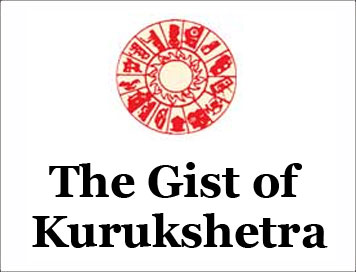(HOT) UPSC Current Affairs 2025 PDF
NEW! The Gist (NOV-2025) | E-BOOKS
(GIST OF KURUKSHETRA) Carbon Farming for Climate Smart Agriculture
(GIST OF KURUKSHETRA) Carbon Farming for Climate Smart Agriculture
(AUGUST-2025)
Carbon Farming for Climate Smart Agriculture
Context:
Agriculture, one of the main sectors directly and indirectly linked to the Sustainable Development Goals (SDGs), requires a holistic approach to develop production models that sustain both people and the planet. Climate change exacerbates the environmental impacts of agriculture by reducing crop yields, intensifying soil erosion, and increasing greenhouse gas (GHG) emissions, underscoring the urgent need for sustainable and climate-resilient agricultural practices.
Carbon Farming
-
Carbon farming refers to the adoption of agricultural practices that increase the sequestration of atmospheric carbon dioxide in soils and vegetation. These practices not only mitigate climate change but also enhance soil fertility, water retention, and crop resilience.
-
Carbon farming is a system of agricultural management that helps the land accumulate and store more greenhouse gases instead of releasing those gases into the atmosphere. Carbon farming transforms agriculture from being a net emitter of carbon dioxide (CO2) to a net sequester of CO2.
-
Because carbon farming uses the natural process of photosynthesis in conjunction with the improvement of soil organic matter to capture and store carbon, it is incredibly effective at sequestering CO2.
-
But in India, where 85% of the farming population are smallholder farmers (GOI, 2021), carbon farming remains underutilised. Farmers receive one carbon credit for removing one tonne of carbon emissions.
Core Carbon Farming Practices
Forest Management
-
Healthy forests are important in reducing climate change by serving as natural carbon sinks, capturing and sequestering carbon dioxide (CO2) from the atmosphere. Sustainable forest management interventions help in sequestering GHG through avoided deforestation, reforestation, afforestation, and enhanced forest conservation measures.
-
Also, agroforestry, the combination of trees and shrubs in agricultural landscapes, sequesters carbon while offering co-benefits like biodiversity conservation soil improvement, and diversified farmer income in the form of timber, fruits, and non-timber forest products. Trees sequester CO2 through photosynthesis, locking carbon in their biomass (trunks, roots, leaves) and the soil. By integrating traditional forestry with climate-smart agriculture, India can increase its carbon sequestration capacity while sustaining rural livelihoods and ecosystem resilience.
Grasslands Conservation
-
Natural sources of greenhouse gas (GHG) absorption and sequestration include native grasses and other vegetation. Carbon offsets from this category focus on maintaining native plant life through permanent land conservation and avoiding conversion for commercial development or intensive agriculture.
Reduced Fertiliser Application
-
Excessive use of chemical fertilisers undermines soil health and reduces its capacity to sequester carbon, while their energy-intensive production contributes significantly to greenhouse gas emissions.
-
With increasing fertiliser costs, improving nutrient utilisation through lower application rates, precision farming practices, and newer fertiliser technologies offers farmers a cost-saving route. Recent innovations such as controlled-release fertilisers and fertigation systems improve the use of nutrients with even distribution throughout the crop cycle, reduced waste, and inhibited environmental runoff.
-
These methods not only lower input costs but also improve soil carbon retention, crop resilience, and long-term agricultural sustainability. By adopting balanced fertilisation practices, farmers can maintain yields while reducing their carbon footprint, aligning climate action with economic viability.
Biochar Application
-
Biochar (biological charcoal) draws carbon from the atmosphere, providing a carbon sink on agricultural lands.
-
Biochar is biologically unavailable, sequestering fixed carbon in the soil for centuries to millennia, providing a tool to absorb net carbon from the atmosphere.
-
Biochar also lowers the need for fertiliser and slows down water runoff.
Reduced Tillage
-
Traditional tillage practices promote the rapid release of CO2 from soils and lead to soil structural degradation, increased erosion risk, and lower long- term productivity of agricultural lands. In contrast, conservation tillage (e.g. no-till and reduced-till) systems reduce disturbance and can allow maintenance of soil organic matter (SOM) levels, improve water retention and provide significant carbon storage benefits.
-
Reduced or no-tillage systems are sustainable approaches that conserve soil carbon and increase crop yields and long-term sustainability. Using minimum tillage, farmers can shrink their carbon footprint, cut fuel expenses and help establish more resilient agriculture, which can handle climate variation.
Cover Cropping
-
Cover crops play a key role in carbon sequestration and assist in preventing soil erosion, increasing nitrogen fixation in legumes, leading to improved fertility and add, as it is decomposed, organic matter into the soil, which increases organic carbon levels.
-
They also help to reduce weeds, and in a chemical herbicide-free manner, also protect against nutrient runoff through their thick, ground-covering growth and maintain soil moisture.
-
By keeping fields productively covered throughout the year, cover crops disrupt pest cycles, contribute to nutrient cycling and reduce carbon losses from bare soils, all of which makes them a low-cost strategy for building resilient farming systems.
Crop Rotation
-
The health of the soil is influenced by the diversityof the plants and microbes. One way to increase this diversity and reduce the burden of pests and disease that accumulates when planting the same crops is through the practice of crop rotation.
-
Root depth of crops and type of crop rotation could do a favour in fully utilising soil nutrients at different depths and in enhancing soil structure.
4Rs Approach for Nutrient Management
-
The 4Rs of nutrient management include the right time, the right rate, the right source, and the right place.
-
The goal of the 4Rs is to keep nutrients where they are needed, on and in the field. The right time means matching the application of nutrients with crop demand.
-
The right rate refers to aligning the amount of fertiliser with crop nutrient uptake. The right source takes into account the type of fertiliser chosen and whether it has an improved efficiency technology, such as inhibitors, slow or controlled release. And right place is the precise placement of fertiliser such that crops can successfully access nutrients.
Eliminating Bare Fallows
-
Leaving a cultivated land idle and fallow for long periods of time exposes it to loss of carbon brought on by exposures to heat (summer), wind, and rain while enhancing the risk of erosion or weed pressure.
-
Instead, replacing bare fallows with nitrogen-fixing cover crops like clover or vetch has been shown to maintain continuous groundcover, store soil-C, and achieve biological N-fixation to naturally enrich soil-fertility without ‘fiddling’ (i.e., biologically prepare soil for a more productive subsequent crop while decreasing the requirement of synthetic feeds).
-
By eliminating bare fallow periods, farmers can convert idle land into a carbon-capturing asset that improves the health of soils over the long term and makes them more resilient to climate extremes.
Sowing Companion Crops
-
By planting two or more crops within proximity to each other, companion planting increases diversity and can be very beneficial to crops and soil.
-
To maximise crop development and yield, one must be knowledgeable about complementary crops. For example, companion planting is when one crop is planted to repel insects or prevent pests from the main crop.
Rotational Grazing
-
It involves moving animals to fresh grazing areas at regular intervals. This method allows grazed areas to recover faster by minimising erosion and maximising stump regrowth.
-
In return, the flourishing vegetation harnesses the process of photosynthesis to sequester carbon dioxide into the ground, where it is absorbed from the atmosphere.
Silvopasture
-
Silvopasture is the combination of trees and pastures used for livestock grazing. As such, it unites the ecological benefits of forestry and the economic benefits of livestock husbandry.
-
Silvopasture systems increase carbon stored by trees as well as in the soil; they also increase pasture productivity and animal welfare.
Improved Residue Management
In agriculture, it is further possible to maintain soil cover by keeping crop residues in the field. It is not only beneficial to soil fertility and reducing moisture, but also covers the land with mulch or agricultural residues (such as straws) and, in combination with organisms to develop a better soil composition.
Conclusion
Carbon farming is a game-changing revolution in how agriculture interacts with the climate system. Through carbon farming practices, Indian farmers can help increase productivity and climate resilience while also participating in global carbon mitigation efforts. But it requires a joint effort by policymakers, scientists, private players, and farmers to make this vision a reality. A robust carbon market, supported by strong institutions and farmers-focused policies, can help to unleash the full potential of carbon farming, allowing India’s agriculture to flourish in a warming world while undermining a strong sustainable future for generations ahead.
CLICK HERE TO DOWNLOAD FULL PDF
CLICK HERE TO DOWNLOAD UPSC E-BOOKS
Study Material for UPSC General Studies Pre Cum Mains
Get The Gist 1 Year Subscription Online
Click Here to Download More Free Sample Material
<<Go Back To Main Page
Courtesy: Kurukshetra



